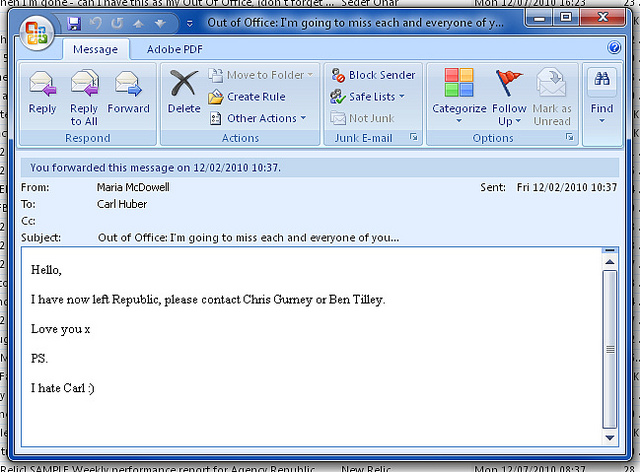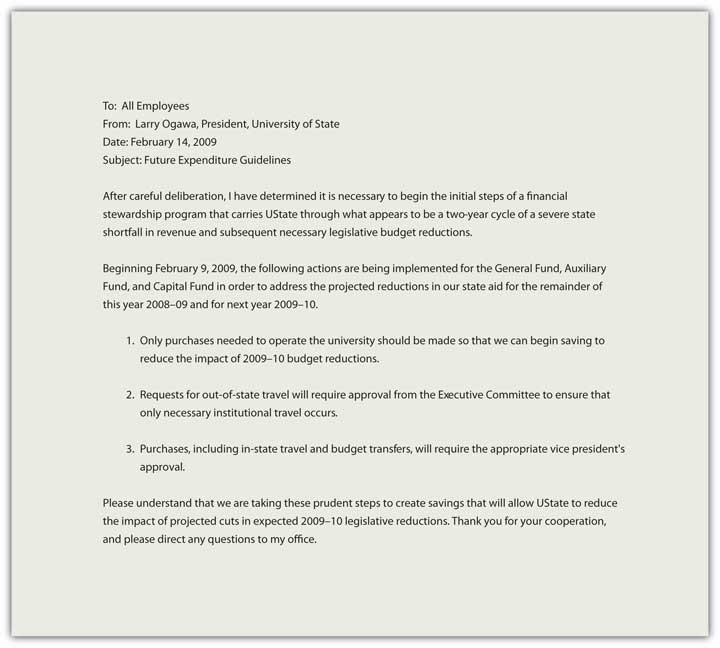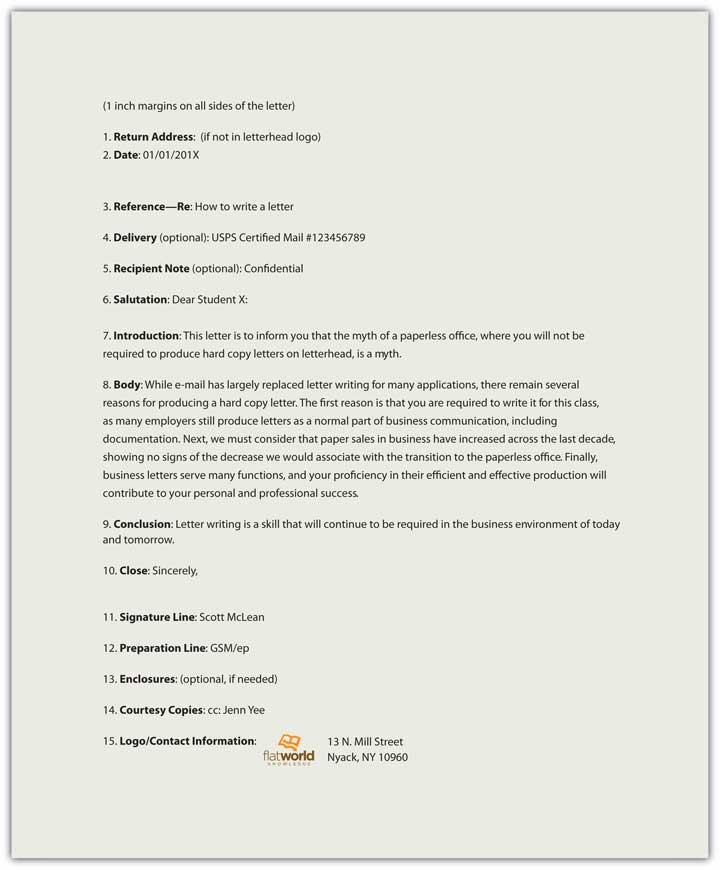6.3 Memorandums and Letters
Southern Alberta Institute of Technology (SAIT)
Memos
A memo (or memorandum, meaning “reminder”) is normally used for communicating policies, procedures, or related official business within an organization. It is often written from a one-to-all perspective (like mass communication), broadcasting a message to an audience, rather than a one-on-one, interpersonal communication. It may also be used to update a team on activities for a given project, or to inform a specific group within a company of an event, action, or observance.
Memo Purpose
A memo’s purpose is often to inform, but it occasionally includes an element of persuasion or a call to action. All organizations have informal and formal communication networks. The unofficial, informal communication network within an organization is often called the grapevine, and it is often characterized by rumor, gossip, and innuendo. On the grapevine, one person may hear that someone else is going to be laid off and start passing the news around. Rumors change and transform as they are passed from person to person, and before you know it, the word is that they are shutting down your entire department.
One effective way to address informal, unofficial speculation is to spell out clearly for all employees what is going on with a particular issue. If budget cuts are a concern, then it may be wise to send a memo explaining the changes that are imminent. If a company wants employees to take action, they may also issue a memorandum. For example, on February 13, 2009, upper management at the Panasonic Corporation issued a declaration that all employees should buy at least $1,600 worth of Panasonic products. The company president noted that if everyone supported the company with purchases, it would benefit all (Lewis, 2009).
While memos do not normally include a call to action that requires personal spending, they often represent the business or organization’s interests. They may also include statements that align business and employee interest, and underscore common ground and benefit.
Memo Format
A memo has a header that clearly indicates who sent it and who the intended recipients are. Pay particular attention to the title of the individual(s) in this section. Date and subject lines are also present, followed by a message that contains a declaration, a discussion, and a summary.
In a standard writing format, we might expect to see an introduction, a body, and a conclusion. All these are present in a memo, and each part has a clear purpose. The declaration in the opening uses a declarative sentence to announce the main topic. The discussion elaborates or lists major points associated with the topic, and the conclusion serves as a summary.
Let us examine a sample memo.
Five Tips for Effective Business Memos
Audience Orientation
Always consider the audience and their needs when preparing a memo. An acronym or abbreviation that is known to management may not be known by all the employees of the organization, and if the memo is to be posted and distributed within the organization, the goal is clear and concise communication at all levels with no ambiguity.
Professional, Formal Tone
Memos are often announcements, and the person sending the memo speaks for a part or all of the organization. While it may contain a request for feedback, the announcement itself is linear, from the organization to the employees. The memo may have legal standing as it often reflects policies or procedures, and may reference an existing or new policy in the employee manual, for example.
Subject Emphasis
The subject is normally declared in the subject line and should be clear and concise. If the memo is announcing the observance of a holiday, for example, the specific holiday should be named in the subject line—for example, use “Thanksgiving weekend schedule” rather than “holiday observance.”
Direct Format
Some written business communication allows for a choice between direct and indirect formats, but memorandums are always direct. The purpose is clearly announced.
Objectivity
Figure 6.4

Memos are a place for just the facts, and should have an objective tone without personal bias, preference, or interest on display. Avoid subjectivity.
Letters
Letters are brief messages sent to recipients that are often outside the organization (Bovee, C., & Thill, J., 2010). They are often printed on letterhead paper, and represent the business or organization in one or two pages. Shorter messages may include e-mails or memos, either hard copy or electronic, while reports tend to be three or more pages in length.
While e-mail and text messages may be used more frequently today, the effective business letter remains a common form of written communication. It can serve to introduce you to a potential employer, announce a product or service, or even serve to communicate feelings and emotions. We will examine the basic outline of a letter and then focus on specific products or writing assignments.
All writing assignments have expectations in terms of language and format. The audience or reader may have their own idea of what constitutes a specific type of letter, and your organization may have its own format and requirements. This chapter outlines common elements across letters, and attention should be directed to the expectations associated with your particular writing assignment. There are many types of letters, and many adaptations in terms of form and content, but in this chapter, we discuss the fifteen elements of a traditional block-style letter.
Letters may serve to introduce your skills and qualifications to prospective employers, deliver important or specific information, or serve as documentation of an event or decision. Regardless of the type of letter you need to write, it can contain up to fifteen elements in five areas. While you may not use all the elements in every case or context, they are listed in Table 6.1
Table 6.1 Elements of a Business Letter
| Content | Guidelines |
|---|---|
| 1. Return Address | This is your address where someone could send a reply. If your letter includes a letterhead with this information, either in the header (across the top of the page) or the footer (along the bottom of the page), you do not need to include it before the date. |
| 2. Date | The date should be placed at the top, right or left justified, five lines from the top of the page or letterhead logo. |
| 3. Reference (Re:) | Like a subject line in an e-mail, this is where you indicate what the letter is in reference to, the subject or purpose of the document. |
| 4. Delivery (Optional) | Sometimes you want to indicate on the letter itself how it was delivered. This can make it clear to a third party that the letter was delivered via a specific method, such as certified mail (a legal requirement for some types of documents). |
| 5. Recipient Note (Optional) | This is where you can indicate if the letter is personal or confidential. |
| Content | Guidelines |
|---|---|
| 6. Salutation | A common salutation may be “Dear Mr. (full name).” But if you are unsure about titles and gender (i.e., Mrs., Ms., Dr.), you may simply write the recipient’s name (e.g., “Dear Cameron Rai”) followed by a colon. A comma after the salutation is correct for personal letters, but a colon should be used in business. The salutation “To whom it may concern” is appropriate for letters of recommendation or other letters that are intended to be read by any and all individuals. If this is not the case with your letter, but you are unsure of how to address your recipient, make every effort to find out to whom the letter should be specifically addressed. For many, there is no sweeter sound than that of their name, and to spell it incorrectly runs the risk of alienating the reader before your letter has even been read. Avoid the use of impersonal salutations like “Dear Prospective Customer,” as the lack of personalization can alienate a future client. |
| 7. Introduction | This is your opening paragraph, and may include an attention statement, a reference to the purpose of the document, or an introduction of the person or topic depending on the type of letter. An emphatic opening involves using the most significant or important element of the letter in the introduction. Readers tend to pay attention to openings, and it makes sense to outline the expectations for the reader up front. Just as you would preview your topic in a speech, the clear opening in your introductions establishes context and facilitates comprehension. |
| 8. Body | If you have a list of points, a series of facts, or a number of questions, they belong in the body of your letter. You may choose organizational devices to draw attention, such as a bullet list, or simply number them. Readers may skip over information in the body of your letter, so make sure you emphasize the key points clearly. This is your core content, where you can outline and support several key points. Brevity is important, but so is clear support for main point(s). Specific, meaningful information needs to be clear, concise, and accurate. |
| 9. Conclusion | An emphatic closing mirrors your introduction with the added element of tying the main points together, clearly demonstrating their relationship. The conclusion can serve to remind the reader, but should not introduce new information. A clear summary sentence will strengthen your writing and enhance your effectiveness. If your letter requests or implies action, the conclusion needs to make clear what you expect to happen. It is usually courteous to conclude by thanking the recipient for his or her attention, and to invite them to contact you if you can be of help or if they have questions. This paragraph reiterates the main points and their relationship to each other, reinforcing the main point or purpose. |
| 10. Close | “Sincerely” or “Cordially” are standard business closing statements. (“Love,” “Yours Truly,” and “BFF” are closing statements suitable for personal correspondence, but not for business.) Closing statements are normally placed one or two lines under the conclusion and include a hanging comma, as in Sincerely, |
| 11. Signature | Five lines after the close, you should type your name (required) and, on the line below it, your title (optional). |
| 12. Preparation Line | If the letter was prepared, or word-processed, by someone other than the signatory (you), then inclusion of initials is common, as in MJD or abc. |
| 13. Enclosures/Attachments | Just like an e-mail with an attachment, the letter sometimes has additional documents that are delivered with it. This line indicates what the reader can look for in terms of documents included with the letter, such as brochures, reports, or related business documents. |
| 14. Courtesy Copies or “CC” | The abbreviation “CC” once stood for carbon copies but now refers to courtesy copies. Just like a “CC” option in an e-mail, it indicates the relevant parties that will also receive a copy of the document. |
| 15. Logo/Contact Information | A formal business letter normally includes a logo or contact information for the organization in the header (top of page) or footer (bottom of page). |
Strategies for Effective Letters
Remember that a letter has five main areas:
- The heading, which establishes the sender, often including address and date
- The introduction, which establishes the purpose
- The body, which articulates the message
- The conclusion, which restates the main point and may include a call to action
- The signature line, which sometimes includes the contact information
Always remember that letters represent you and your company in your absence. In order to communicate effectively and project a positive image,
- be clear, concise, specific, and respectful;
- each word should contribute to your purpose;
- each paragraph should focus on one idea;
- the parts of the letter should form a complete message;
- the letter should be free of errors.
Exercise
Test your knowledge of memos and letters by taking this quiz:



